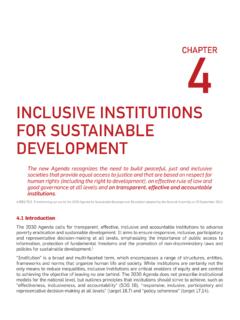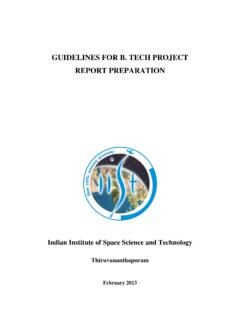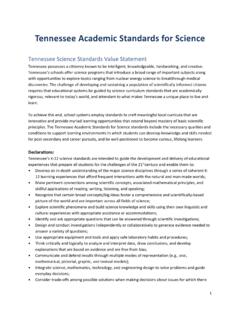Transcription of CH 1APTER
1 chapter . 1 A Life Course Perspective Elizabeth D. Hutchison chapter OUTLINE. Key Ideas Timing of Lives Dimensions of Age Case Study : David Sanchez's Search for Standardization in the Connections Timing of Lives Case Study : Mahdi Mahdi's Shared Journey Linked or Interdependent Lives Case Study : The Suarez Family After Links Between Family September 11, 2001 Members Links With the Wider World A Definition of the Life Course Perspective Human Agency in Making Choices Theoretical Roots of the Life Course Perspective Diversity in Life Course Trajectories Basic Concepts of the Life Course Perspective developmental Risk and Protection Cohorts Strengths and Limitations of Transitions the Life Course Perspective Trajectories Integration With a Multidimensional, Life Events Multitheoretical Approach Turning Points Implications for Social Work Practice Major Themes of the Life Course Perspective Key Terms Interplay of Human Lives and Historical Active Learning Time Web Resources 1.
2 2 DIMENSIONS OF HUMAN BEHAVIOR: THE CHANGING LIFE COURSE. OPENING QUESTIONS. Why do social workers need to understand how people change from conception to death? What do social workers need to know about biological, psychological, social, and spiritual changes over the life course? Why do different people react to the same type of stressful life event in different ways? KEY IDEAS. As you read this chapter , take note of these central ideas: 1. The life course perspective attempts to understand the continuities as well as the twists and turns in the paths of individual lives. 2. The life course perspective recognizes the influence of historical changes on human behavior. 3. The life course perspective recognizes the importance of timing of lives not just in terms of chronological age, but also in terms of biological age, psychological age, social age, and spiri- tual age. 4. The life course perspective emphasizes the ways in which humans are interdependent and gives special attention to the family as the primary arena for experiencing and interpreting the wider social world.
3 5. The life course perspective sees humans as capable of making choices and constructing their own life journeys within systems of opportunities and constraints. 6. The life course perspective emphasizes diversity in life journeys and the many sources of that diversity. 7. The life course perspective recognizes the linkages between early life experiences and later expe- riences in adulthood. Case Study David Sanchez's Search for Connections David Sanchez has a Hispanic name, but he explains to his social worker, as he is readied for discharge from the hospital, that he is a member of the Navajo tribe. He has spent most of his life in New Mexico but came to Los Angeles to visit his son Marco, age 29, and his grandchildren. While he was visiting them, he was brought to the emergency room and then hospitalized for what has turned out to be a diabetic coma. He had been aware of losing weight during the past year, and felt ill at times, but thought chapter 1 A Life Course Perspective 3.
4 These symptoms were just signs of getting older, or perhaps, the vestiges of his alcoholism from the ages of 20 to 43. Now in his 50s, although he has been sober for seven years, he is not surprised when his body reminds him how he abused it. The social worker suggests to Mr. Sanchez that he will need to follow up in the outpatient clinic, but he indicates that he needs to return to New Mexico. There he is eligible because he is a Vietnam veteran for health services at the local Veterans Administration (VA) hospital outpatient clinic. He also receives a disabil- ity check for a partial disability from the war. He has not been to the VA since his rehabilitation from alcohol abuse, but he is committed to seeing someone there as soon as he gets home. During recent visits with Marco and his family, David started to recognize how much his years of alcohol abuse hurt his son. After Mrs. Sanchez divorced David, he could never be relied on to visit Marco or to pro- vide child support.
5 Now that Marco has his own family, David hopes that by teaching his grandchildren the ways of the Navajo, he will pay Marco back a little for neglecting him. During the frequent visits of this past year, Marco has asked David to teach him and his son how to speak Navajo. This gesture has broken down some of the bad feelings between them. David has talked about his own childhood during recent visits, and Marco now realizes how much his father suffered as a child. David was raised by his maternal grandmother after his father was killed in a car accident when David was 7. His mother had been very ill since his birth and was too overwhelmed by her hus- band's death to take care of David. Just as David became attached to his grandmother, the Bureau of Indian Affairs (BIA) moved him to a boarding school. His hair was cut short with a tuft left at his forehead, which gave the teachers something to pull when he was being reprimanded. Like most Native American/First Nations children, David suffered this harshness in silence.
6 Now, he feels that it is important to break this silence. He has told his grandchildren about having his mouth washed out with soap for speaking Navajo. He jokes that he has been baptized in four different religions Mormon, Catholic, Lutheran, and Episcopalian because these were the religious groups running the boarding schools he attended. He also remembers the harsh beatings for not studying, or for committing other small infractions, before the BIA changed its policies for boarding homes and the harsh beatings diminished. David often spent holidays at the school, because his grandmother had no money for transportation. He remembers feeling so alone. When David did visit his grandmother, he realized he was forgetting his Navajo and saw that she was aging quickly. He joined the Marines when he was 18, like many high school graduates of that era, and his grandmother could not understand why he wanted to join the White man's war. David now recognizes why his grand- mother questioned his decision to go to war.
7 During his alcohol treatments, especially during the use of the Native sweat lodge, he often relived the horrible memories of the bombings and killings in Vietnam; these were the memories he spent his adult life trying to silence with his alcohol abuse. Like many veterans, he ended up on the streets, homeless, seeking only the numbness his alcoholism provided. But the memories were always there. Sometimes his memories of the children in the Vietnam villages reminded him of the chil- dren from the boarding schools who had been so scared; some of the Vietnamese children even looked like his Native American friends. (Continued). 4 DIMENSIONS OF HUMAN BEHAVIOR: THE CHANGING LIFE COURSE. (Continued). It was through the Native American medicine retreats during David's rehabilitation that he began to touch a softer reality. He began to believe in a higher order again. Although his father's funeral had been painful, David experienced his grandmother's funeral in a more spiritual way.
8 It was as if she was there guiding him to enter his new role. David now realizes this was a turning point in his life. At his grandmother's funeral, David's great-uncle, a medicine man, asked him to come and live with him because he was getting too old to cut or carry wood. He also wanted to teach David age-old cures that would enable him to help others struggling with alcohol dependency, from Navajo as well as other tribes. Although David is still learning, his work with other alcoholics has been inspirational, and he finds he can make special connections to Vietnam veterans. Recently, David attended a conference where one of the First Nations speakers talked about the trans- generational trauma that families experienced because of the horrible beatings children encountered at the boarding schools. David is thankful that his son has broken the cycle of alcoholism and did not face the phys- ical abuse to which he was subjected. But he is sad that his son was depressed for many years as a teen and young man.
9 Now, both he and Marco are working to heal their relationship. They draw on the meaning and strength of their cultural and spiritual rituals. David's new role as spiritual and cultural teacher in his family has provided him with respect he never anticipated. Finally he is able to use his grandmother's wise teach- ings and his healing apprenticeship with his great-uncle to help his immediate family and his tribe. A social worker working a situation like this helping Mr. Sanchez with his discharge plans must be aware that discharge planning involves one life transition that is a part of a larger life trajectory. Maria E. Zuniga Case Study Mahdi Mahdi's Shared Journey Social workers involved in refugee resettlement work are eager to learn all they can about the refugee experience. Social workers in these scenarios are learning from their clients, but they will also find it helpful to talk with other resettlement workers who have made a successful adjustment after entering the United States as refugees.
10 In this particular case, the social worker has been particularly grateful for what she has learned from conversa- tions with Mahdi Mahdi. Mahdi works as an immigration specialist at Catholic Social Services in Phoenix, pro- viding the kind of services that he could have used when he came to Phoenix as a refugee in 1992. Mahdi was born in Baghdad, Iraq, in 1957. His father was a teacher, and his mother stayed at home to raise Mahdi and his four brothers and two sisters. Mahdi remembers the Baghdad of his childhood as a mix of old and new architecture and traditional and modern ways of life. Life in Baghdad was very good for him until about 1974, when political unrest and military control changed the quality of life. Mahdi and his wife were married after they graduated from Baghdad University with degrees in fine arts in 1982. Mahdi started teaching high school art when he graduated from college, but he was immediately drafted as an officer in the military to fight in the Iran-Iraq War.
















